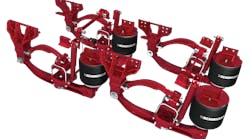AERODYNAMIC drag has become a hot topic as the truck and trailer industry anticipates the first fuel economy standards on trailers, which made the Daimler Trucks North America’s (DTNA) SuperTruck announcement at this year’s Mid-America Trucking Show particularly timely.
Developed as part of a $40 million grant program, the custom Freightliner tractor, coupled to a specially designed Strick trailer, demonstrated its fuel efficiency. The final SuperTruck demonstrator ran a five-day, 312-mile round trip route on Interstate 35 between San Antonio and Dallas. Loaded at a weight of 65,000 pounds and running at a speed of 65 mph, SuperTruck achieved an average result of 12.2 mpg, according to Freightliner.
“More than two-thirds of the benefits come from the trailer,” says Derek Rotz, global engineering for DTNA. “But SuperTruck really is designed as a system, an integrated tractor and trailer.”
DTNA selected Strick for the program in 2012. Since then, Strick has built several trailers for the program.
“We provided a base trailer,” Strick’s Charlie Willmott says. “Adding trailer skirts and boat tails go a long way in reducing aerodynamic drag. But it was Freightliner who came up with a lot of incremental design changes that further improved the trailer’s efficiency.”
The trailer is based on a Strick TFI model—a 53-ft by 102-inch sheet and post design.
“It’s back to the future,” Willmott says. “Sheet and post construction offers a major advantage over the newer composite sidewall designs—it’s much lighter. I think as we seek ways to save fuel consumption, we are going to appreciate light weight even more than we do today. The benefits of aerodynamics are conditional. How fast do you go? How long are you operating at highway speeds? With weight reductions, you benefit every day under all conditions.”
Refining the trailer design was a team effort.
“We developed a basic shape, and Stick helped us refine it,” Rotz says. “We provided a three-dimensional model, and they offered feedback.”
Stick has built two models since becoming part of the program. Modifications are ongoing, but the base dimensions remain unchanged.
“We always have to balance out customer needs, size and weight laws, and the desire to improve fuel efficiency,” Willmott says. “The ideal shape for a van trailer is that of a kayak, but that doesn’t mean a kayak-shaped trailer is ideal for the customer. Likewise, we recognize the value of weight reduction, but the trailer still has to carry the load and prove itself to be durable.”
Impressive results
Daimler’s program has exceeded its goals, the company said. SuperTruck achieved 115 percent freight efficiency improvement, surpassing the Department of Energy (DOE) program’s goal of 50 percent.
To validate the targets set by the DOE, DTNA engineers conducted a series of tests. To measure freight efficiency, DTNA ran vehicle testing on highway routes in Oregon and Texas, one city route in Portland, Ore., and anti-idle testing in both a cold chamber and hot chamber. These tests resulted in a combined 115 percent freight efficiency improvement over a 2009 baseline truck.
Some of the features of the tractor are not expected to be available for a decade or more. Others, however, already have been introduced in DTNA production vehicles, including 6x2 optimization and the aerodynamic components found on the Freightliner Cascadia® Evolution and the integrated Detroit Powertrain.
Strategies such as downspeeding with a custom engine rating and using the predictive capabilities of Intelligent Powertrain Management (IPM) components such as pre-loaded 3D digital maps to control shifting and eCoast events also increased efficiency and economy.
“By incorporating a mix of available technologies with future innovations, we were able to use the SuperTruck program to take the first steps in seeing what may be technically possible and commercially viable,” said Rotz. “We still have a long road ahead to determine ultimately what will be successful and what will achieve the greatest efficiencies.”
The SuperTruck team discovered that some of these components, due to regulatory or economic barriers, may not be commercially viable in the near future.
About the program
Sponsored by the U.S. Department of Energy (DOE), the SuperTruck program was a five-year research and development initiative to improve freight efficiency by at least 50 percent, brake thermal efficiency by 50 percent, and reduce fuel consumption and greenhouse gas emissions of Class 8 trucks. DTNA and three other major truck OEMs were awarded multi-million dollar grants by the DOE and each matched the DOE funding dollar for dollar.
SuperTruck is supported by the U.S. DOE under the American Recovery and Reinvestment Act of 2009. DTNA began work on the SuperTruck program in 2010 together with Detroit and other partners, including national labs, universities and suppliers. ♦













